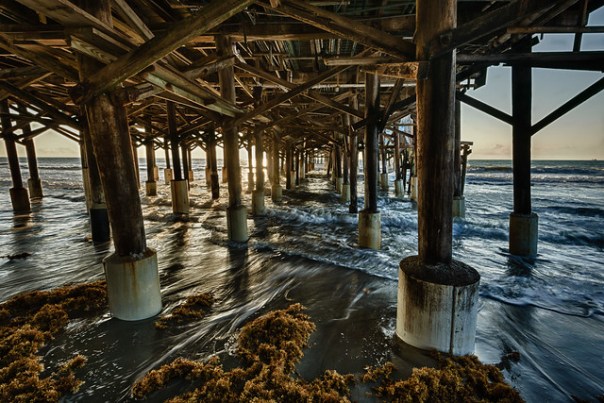Intro / Description
What a beautiful place.
I’d seen a few mentions online of Blue Cypress Lake near Vero Beach, Florida. It’s a long drive from Winter Springs – which is why I hadn’t made it down there. But that’s also why I was up at “0 dark thirty” last Saturday. Fortunately, I packed the night before so I was able to sleep in just a bit. I also didn’t want to arrive in the dark on my first time there. So Kevin M. and I met at 5:30 near his house and were off. There was a lot of fog and drizzle on our drive down, although it eventually cleared up and the clouds added some drama to the skies. We turned in to Blue Cypress Lake Road just after 7am, but were delayed by stops for photos of Wild Turkeys in the fields on the west side and three Otters playing in the road up near the lake.
At Middleton’s Fish camp, we first parked near the camp sites, but couldn’t really see much from the shore – although with the right lens a sunrise shot from the bridge over the canal might be very pretty. We decided to rent a small boat to explore out in the water and wow, I’m glad we did! We went north and scouted the trees, shoreline, and birds for about two hours.
The calm water and weathered cypress trees make for some outstanding scenery. We also saw literally hundreds of Ospreys and a good portion of them were carrying or eating fish. There were also plenty of alligators, a few quite large. Black-bellied Whistling Ducks were also numerous and they serenaded us the whole morning. We heard an eagle but didn’t see it and although there are supposed to be hawks and barred owls, we didn’t see any of them.

Osprey Family – One of the many nests on Blue Cypress Lake. Many are just a few feet from the water. (Photo courtesy of Kevin McKinney)
Info for Photographers
Photo hints:
According to the locals, the best cypress trees are on the west side of the lake (where Middleton’s is) both north and south of the canal. For sunrise shots, you’d probably want to get between the shore and some of the farther out trees. This might be tough, especially in the dark if you don’t know the lake. Be careful of hidden snags / submerged fallen trees that could hang you up! If you’re on the lake later in the day, a safer photo might be an evening sunset from a little farther out with a telephoto lens.

Many cypress trees: The north-west shore of Blue Cypress Lake, Black & White, Infrared
If you have an IR camera or filter, YOU MUST BRING IT to Blue Cypress Lake! I just love the way Cypress trees show up in infrared.
Depending on how much time you have available, there are a couple of other places you could check out in the area. On the way home, we went by Joe Overstreet Road. On the way we saw (and I finally got a photo of) a Swallow-tailed Kite. When we arrived, we saw Eastern Meadowlarks, Sandhill Cranes, Red-bellied Woodpeckers, a Bobwhite, egrets, herons, and other birds. We hoped to see a Whooping Crane, but no such luck.

Swallow-tailed Kite with snake
Tripod/Monopod:
I brought mine, but didn’t use it out on the lake. It’s not much use inside the boat. Although many people get out into the water to use theirs, I was a bit leery of doing this. If you do, just be very careful of the depth and your footing and be sure to watch for alligators!
Lenses:
I had a 16 – 35mm on one camera and a 28 – 82 equivalent on the other. I felt the 16 – 35 was a bit too wide for the conditions. Next time I go, I think a 24 – 70 would be ideal for Cypress trees / landscapes. For birds of course, you’ll want a stabilized telephoto lens that you can handhold in a moving boat. Kevin used his 70 – 300VR on his DX crop body for some great shots.
Best time to visit:
If you go in February – April, you’ll be able to see Osprey’s nesting, breeding and raising their young. Some of the nests are quite close to the water so you can get an excellent look. Just be sure you don’t stress the birds.
There will still be many Ospreys around to photograph the rest of the year. Many of them are fishing and carrying their catch back to a convenient tree, so opportunities for flight shots of these magnificent birds with their prey abound.
Of course, the cypress trees are here year round.
Other:
Middleton’s Fish Camp offers tours and rents boats, and cabins. If you also fish, they rent fishing tackle and sell bait. If you do want to rent or take a tour, call ahead for availability.
Summary
| My Gallery / Flickr photo set: | My Blue Cypress Lake photos on Flickr |
|---|---|
| Website: | http://www.middletonsfishcamp.com/ |
| Address / Phone: |
21704 73rd Manor 1-800-258-5002 |
| Central Florida Photo Ops Rating: | Central Florida Photo-Op must do! |
A wonderful, wonderful trip.
Thanks for stopping by and reading my blog. Now, go make some photos!
©2012, Ed Rosack. All rights reserved.

























